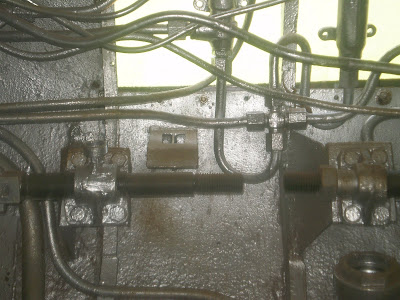

The USS Bowfin is held in place by enormous anchors and chains.

Here you can walk among many items taken from ships or submarines to see what equipment or weaponry was used during WWII.


A submarine rocket or subroc. An underwater-to-air-to-underwater anti-submarine missile was in use from 1965 to 1990. It was designed to be fired from a submierged nuclear fast attack submarine.

 The inside of a kaiten or suicide submarine.
The inside of a kaiten or suicide submarine.
Frazier looks through a periscope that was part of a conning tower for the USS Parche (SS-384), a sister ship to the Bowfin.

 The conning tower is an eight feet diameter cylinder located above the control room of a submarine’s pressure hull. The conning tower contained equipment for steering the submarine and firing torpedoes. It was the command center of a WWII submarine and the battle station for the commanding officer.
The conning tower is an eight feet diameter cylinder located above the control room of a submarine’s pressure hull. The conning tower contained equipment for steering the submarine and firing torpedoes. It was the command center of a WWII submarine and the battle station for the commanding officer.

 The conning tower is an eight feet diameter cylinder located above the control room of a submarine’s pressure hull. The conning tower contained equipment for steering the submarine and firing torpedoes. It was the command center of a WWII submarine and the battle station for the commanding officer.
The conning tower is an eight feet diameter cylinder located above the control room of a submarine’s pressure hull. The conning tower contained equipment for steering the submarine and firing torpedoes. It was the command center of a WWII submarine and the battle station for the commanding officer.

A submarine rocket or subroc. An underwater-to-air-to-underwater anti-submarine missile was in use from 1965 to 1990. It was designed to be fired from a submierged nuclear fast attack submarine.

A 40-mm quad gun assembly, used on destroyer escorts and all classes of larger ships, consisted of four recoil-operated, heavy machine guns, designed primarily for anti-aircraft fire. Each gun had a firing rate of 120 rounds/minute and fired a 2 lb projectile at a maximum horizontal range of approximately 33,000 feet and maximum ceiling range of 22,800 feet.

‘Kaiten’ means to make a radical reverse in the course of events. It was an enlarged torpedo with a small cockpit, a periscope and manual controls for steering, speed and depth. It had a pure oxygen-fed kerosene-burning 550 horsepower engine and a huge 3,000 lb explosive warhead which could be detonated on impact or by an electrical switch controlled by the pilot.
Kaiten were transported by submarine to ‘firing position’ which was 3.5 – 4.5 miles from the target. The only kaiten known to have sunk a U.S. Navy ship hit the fleet oiler USS Mississinewa at Uluthi on Nov. 20, 1944.
Kaiten were transported by submarine to ‘firing position’ which was 3.5 – 4.5 miles from the target. The only kaiten known to have sunk a U.S. Navy ship hit the fleet oiler USS Mississinewa at Uluthi on Nov. 20, 1944.
The propellor of the kaiten.
Submarine Rescue Chamber
These chambers were used by the U.S. Navy for over 50 years to rescue crews of submarines stranded on the ocean floor. It had two chambers inside; the upper held two operators and eight passengers; the lower helped survivors to pass from the submarine’s escape hatch into the rescue chamber.
The first and only operation use of the submarine rescue chamber was in 1939 when the USS Squalus accidentally flooded her aft compartment during a test dive. Divers from the rescue vessel USS Falcon attached a downhaul cable from the chamber and make several trips to the surface until 33 survivors were brought to safety.




No comments:
Post a Comment